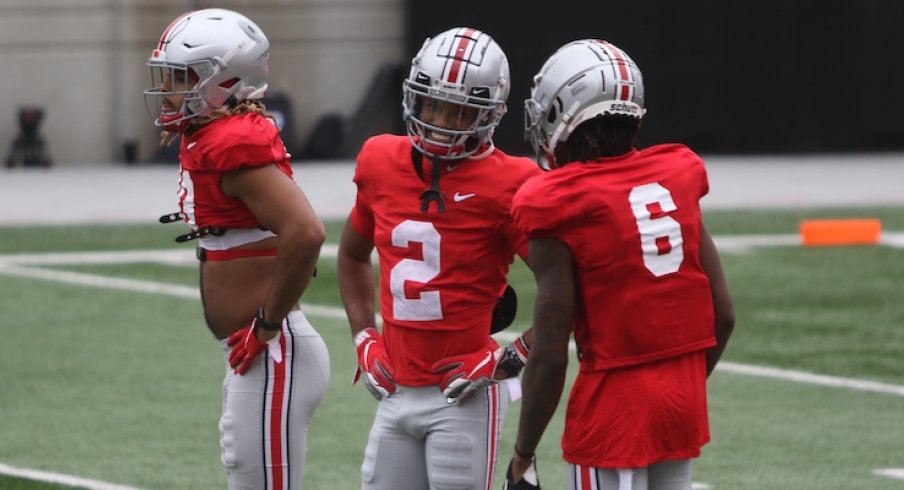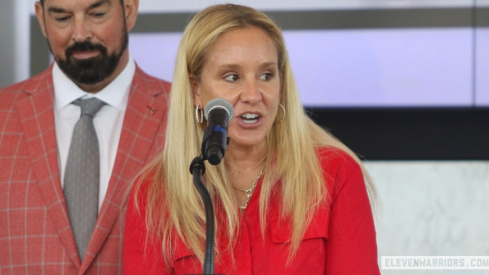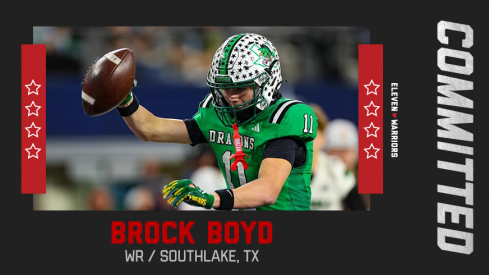2026 four-star wide receiver Brock Boyd flips his commitment from TCU to Ohio State.
Some version of the exact same question has gotten asked frequently over the past nine months.
How will Justin Fields be different in Year 2 as Ohio State’s starting quarterback?
It’s only natural to ponder, considering what he did on the field in 2019, though the answer doesn’t appear obvious.
As a first-time starter last year, the 6-foot-3, 228-pounder had a 41-to-3 touchdown-to-interception ratio with 10 rushing touchdowns. He led his team to the College Football Playoff, was a Heisman Trophy finalist and finds himself now viewed as a likely top-10 pick in the 2021 NFL Draft. How can he get much better?
Fields’ teammates and coaches have harped on his improved leadership throughout the offseason, so perhaps what changed about him between 2019 and 2020 largely lies within intangibles. Maybe he becomes a quicker decision-maker in the pocket or gets better at avoiding sacks in his second year leading the offense.
Or, quite possibly, the biggest difference in Fields might have less to do with him and more to do with the weapons surrounding him.
Last year’s crop of wide receivers featured a trio of seniors – K.J. Hill, Binjimen Victor and Austin Mack – along with two underclassmen in then-sophomore Chris Olave and then-freshman Garrett Wilson. The upperclassmen were experienced, fairly reliable pass-catchers and solid blockers. Along with J.K. Dobbins in the backfield, they provided Fields with enough talent to power an offense that ranked seventh nationally with 6.94 yards per play.
But the three outgoing upperclassmen – who ran 40-yard-dash times of 4.59, 4.60 and 4.60 seconds at the 2020 NFL Combine – weren’t game-breakers. They weren’t big-play threats whose speed kept defenses on their toes. Hill’s biggest strength was his hands, Mack’s was his physicality and route-running and Victor’s was his length. What they could do worked out just fine for the Buckeyes. Collectively, though, they didn’t play similarly to the receivers in line to replace them in Columbus.
The next wave of wideouts to take over spots in Brian Hartline's room lacks game experience. As many as five underclassmen and three freshmen might be part of a six-man rotation. But as a whole, they should offer the type of explosiveness that quarterbacks dream about.
Olave, who led the rotation receivers with 17.5 yards per reception and 12 touchdowns last season, returns to again man an outside receiver spot. He developed quick chemistry with Fields, becoming the No. 1 downfield option early in the year and maintaining the title for the duration of the campaign. As a junior, the potential first-round pick wants to end the season known as the country’s top wideout.
“I feel like, when I put the team first, the individual things will come,” Olave said.
Outside of Olave, everything else at receiver as changed.
Even Wilson, a rotational wide receiver as a freshman last season, has moved from the outside to the slot. Hill started in the slot for the past couple of season, but with him gone, Hartline shifted Wilson inside where he’ll have a chance to possibly lead the team in catches. Hartline called Wilson the type of “dynamic” player who thrives on the inside.
Hill was as steady as receivers come. He caught just about everything thrown his way, as evidenced by him holding Ohio State’s all-time reception record. But given what Wilson has shown thus far in his collegiate career, both as a down-the-field option and as someone who can win with short-area quickness and spacial awareness, he presumably allows Fields to have some added explosiveness out of the slot.
“I think that Garrett being a smart, savvy, he's got a lot of good wiggle to him when it comes to releases and operating space,” Hartline said. “I think he's a great fit for that space.”
Everybody else entering Ohio State’s receiver rotation will do so for the first time, including sophomore Jameson Williams.
The speedster from St. Louis showed a peek at the talent that once made him a top-100 overall recruit on a 61-yard touchdown catch and run versus Miami (Ohio) last fall. Williams didn’t play much as a true freshman due to the veterans ahead of him, but he might have been the fastest player at his position group even as a benchwarmer who largely appeared at the end of blowouts to record just six catches.
Hartline said he has implored Williams to try to keep this in mind: “What if I wasn’t that fast?”
That question, of course, only ever gets posed from a coach to someone who's really, really, really fast. It’s something Parris Campbell – who clocked a 4.31-second 40-yard dash – used to ponder.
“If you're able to embody that approach, a really special player can come out of that,” Hartline said. “He already has a physicality that a lot of receivers don't have.”
Outside of Olave, Wilson and Williams, it remains unclear exactly who else will join them in the Buckeyes’ rotation. As of now, though, three freshmen – Julian Fleming, Gee Scott Jr. and Jaxon Smith-Njigba – appear most likely to do so.
This trio could be a heck of a lot different from last year’s trio.
Hill, Mack and Victor were seniors. Fleming, Scott and Smith-Njigba are freshmen. Those were solid, known commodities. These are high-ceiling wideouts who’ve never played a snap as Buckeyes but who were each ranked among the best 100 players in their recruiting class.
More so than anywhere else in the room, they personify the difference in the wide receiver rotation as it goes from more experienced to more explosive.
So, how will Fields be different in 2020? Well, the weapons surrounding him at receiver – Olave, Wilson, Williams, Fleming, Scott, Smith-Njigba and others – might just answer that question for him.


